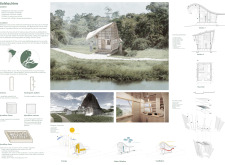5 key facts about this project
### Project Overview
The BioMachine is located along the Amazon River in South America, addressing key issues of environmental resilience and community sustainability in a region vulnerable to flooding and ecological challenges. This architectural design employs innovative construction techniques and environmentally friendly materials to mitigate the impact of seasonal flooding while promoting a self-sustaining lifestyle for residents.
### Materiality and Structural Design
The project features a range of sustainable materials, notably including bamboo, known for its rapid growth and strength, and mycelium-based panels that provide insulation and promote biodiversity. These components contribute to the overall ecological ethos of the design. The dynamic roof form not only enhances the aesthetic value but also facilitates rainwater collection and natural ventilation, thereby minimizing reliance on energy-intensive mechanical systems.
The interior layout emphasizes openness and flexibility, promoting social interaction while accommodating various community activities. Water filtration and hydroponic systems integrated into the building facilitate sustainable living by ensuring a reliable water supply and enabling food production without traditional soil farming.
### Community Integration and Environmental Response
The design incorporates dedicated communal spaces aimed at fostering collaboration and enhancing community ties. This focus on social interaction supports local resilience and encourages sustainable practices among residents. The building’s responsiveness to its ecological context is evident through adaptive design strategies that align with the surrounding landscape, making it a reference model for future developments in ecologically sensitive areas.



















































